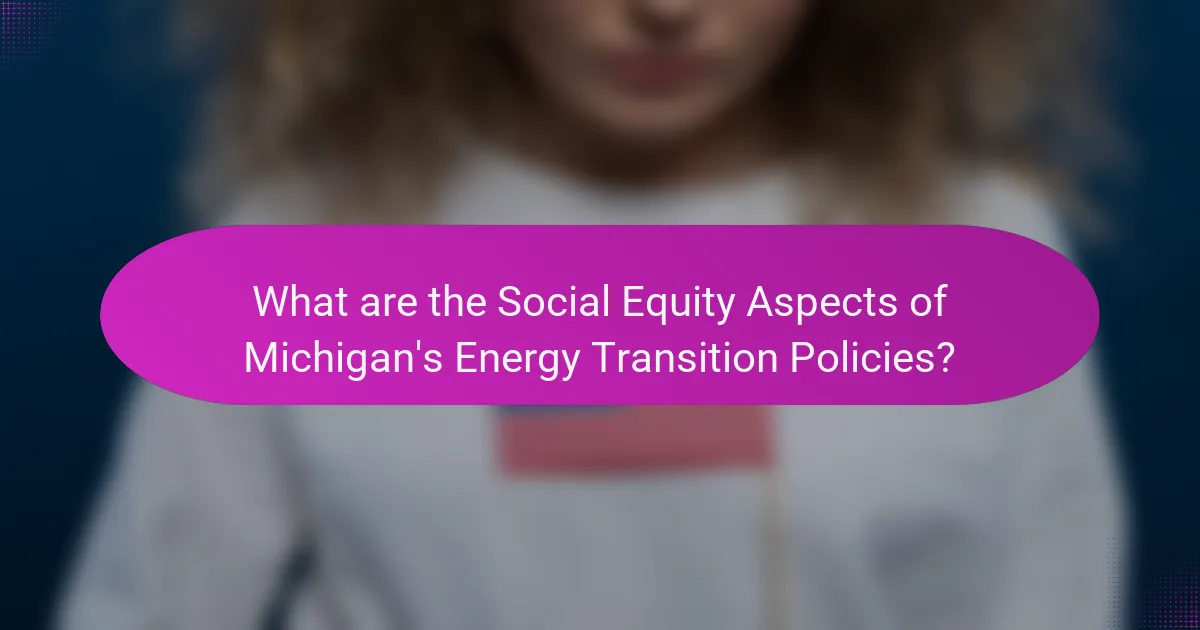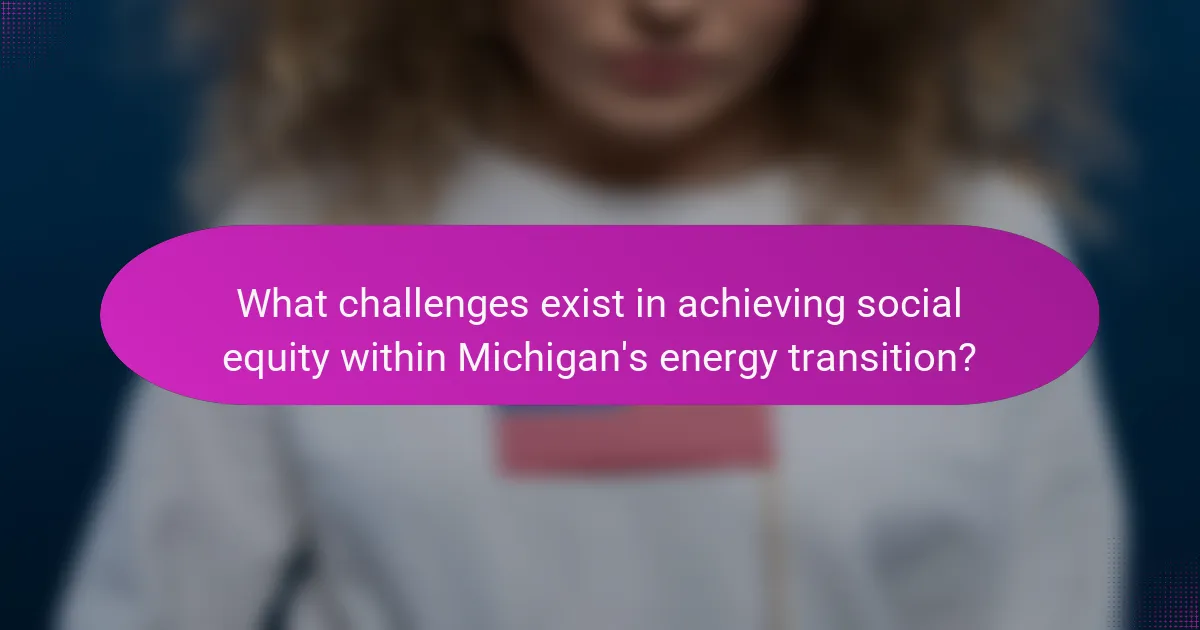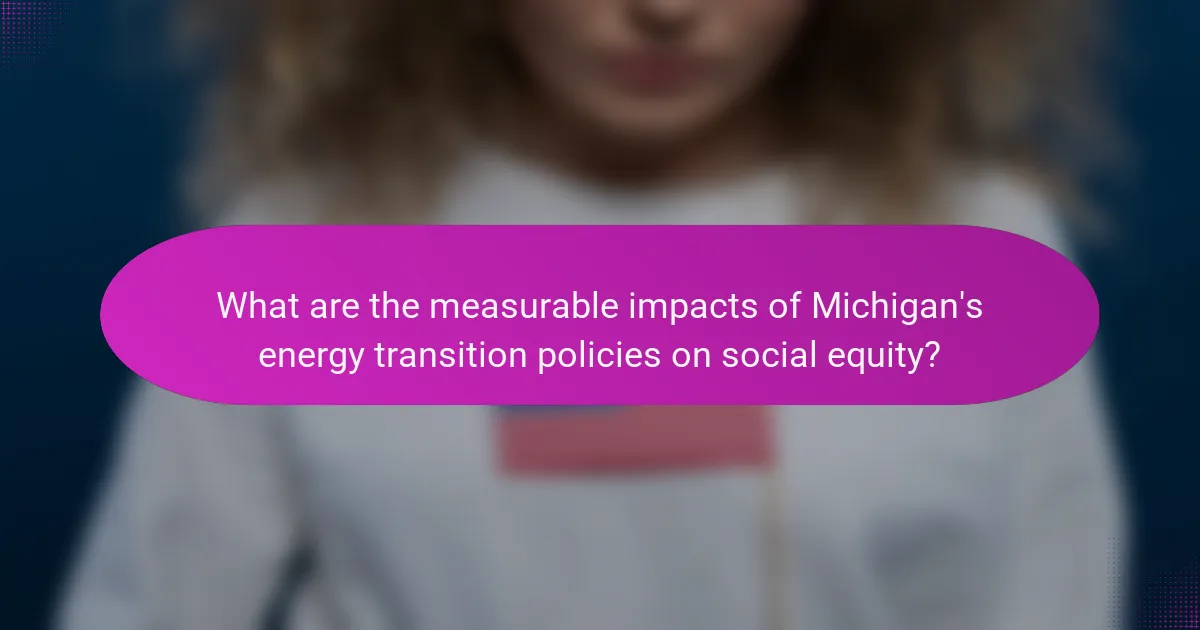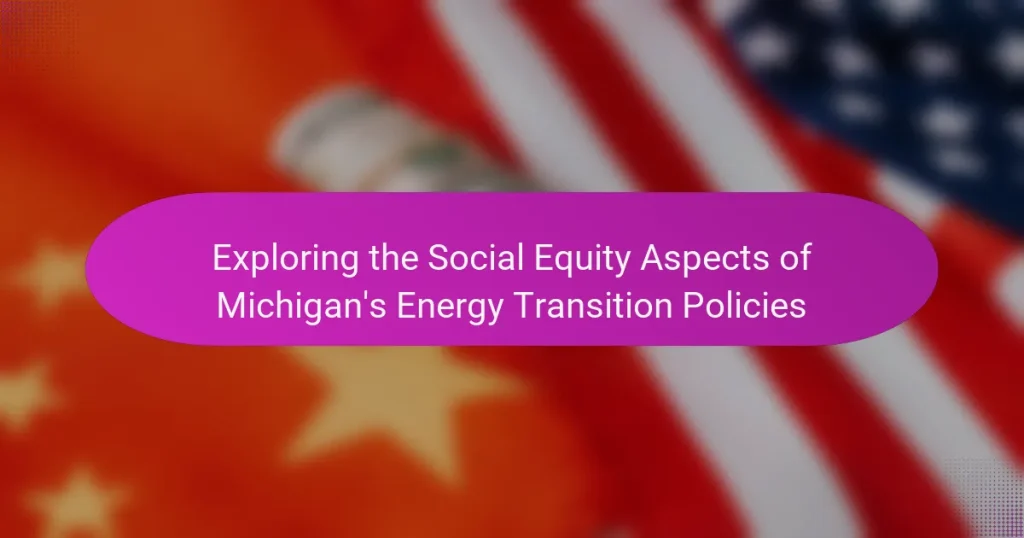
What are the Social Equity Aspects of Michigan’s Energy Transition Policies?
Michigan’s energy transition policies prioritize social equity by addressing disparities in energy access and affordability. These policies aim to ensure that low-income communities benefit from renewable energy initiatives. They include provisions for job training programs targeted at marginalized groups. Additionally, there are incentives for energy efficiency upgrades in underserved neighborhoods. The state emphasizes community engagement in decision-making processes. These measures are designed to create equitable opportunities in the growing clean energy sector. Overall, Michigan’s approach seeks to mitigate historical injustices in energy distribution.
How do these policies aim to promote social equity?
These policies aim to promote social equity by ensuring fair access to clean energy resources. They address historical disparities faced by marginalized communities in Michigan. The policies include provisions for low-income households to receive financial assistance for energy efficiency upgrades. They also prioritize investments in renewable energy projects within underserved areas. Additionally, the policies establish job training programs specifically for residents of these communities. This approach helps to create equitable employment opportunities in the growing green energy sector. By focusing on inclusivity, these policies strive to reduce energy burdens and enhance overall community resilience.
What specific social equity goals are outlined in the policies?
The specific social equity goals outlined in Michigan’s energy transition policies include increasing access to clean energy for underserved communities. These policies aim to reduce energy burdens on low-income households. They also focus on creating job opportunities in the renewable energy sector for marginalized groups. Another goal is to ensure equitable distribution of resources and benefits from energy programs. Additionally, the policies seek to enhance community engagement in energy decision-making processes. These goals are designed to address historical inequities in energy access and environmental justice.
How are marginalized communities impacted by these policies?
Marginalized communities often face disproportionate negative impacts from energy transition policies. These policies can lead to increased energy costs, making it harder for low-income households to afford utilities. Additionally, marginalized communities may experience reduced access to clean energy resources. This can exacerbate existing inequalities in health and economic stability. For example, studies indicate that low-income neighborhoods often have fewer renewable energy projects. Consequently, these communities miss out on job opportunities in the emerging green economy. Furthermore, energy transition policies may not adequately address the historical injustices faced by these populations. Without targeted interventions, marginalized communities risk being left behind in the energy transition.
Why is social equity important in energy transition?
Social equity is crucial in energy transition because it ensures fair access to energy resources and benefits. This principle addresses historical injustices faced by marginalized communities. By promoting social equity, energy policies can reduce disparities in energy access and affordability. For instance, low-income households often spend a higher percentage of their income on energy bills. Ensuring equitable energy transition can lead to improved health outcomes and economic opportunities for these communities. Research indicates that equitable energy policies can enhance overall societal resilience during transitions. Prioritizing social equity fosters community engagement and support for sustainable energy initiatives.
How does social equity influence energy access and affordability?
Social equity significantly influences energy access and affordability. It ensures that all communities, especially marginalized ones, have equal opportunities for energy resources. Disparities in income and race often lead to unequal energy access. For instance, lower-income households may struggle to pay energy bills, resulting in energy poverty. According to the American Council for an Energy-Efficient Economy, low-income families pay a higher percentage of their income on energy. Social equity initiatives can address these disparities through policy changes. Programs that provide financial assistance or subsidies can enhance energy affordability for disadvantaged groups. Additionally, equitable access to renewable energy sources can promote sustainability across all communities.
What role does social equity play in environmental justice?
Social equity is essential to environmental justice as it ensures fair treatment and meaningful involvement of all individuals in environmental decision-making. This principle addresses the disproportionate impact of environmental hazards on marginalized communities. In the context of Michigan’s energy transition policies, social equity aims to rectify historical injustices faced by low-income and minority populations. Studies show that these communities often bear the brunt of pollution and climate change effects. By integrating social equity into policy frameworks, stakeholders can promote inclusive access to clean energy resources. This approach fosters a more equitable distribution of environmental benefits and burdens. Ultimately, social equity enhances community resilience and promotes sustainable development.

What challenges exist in achieving social equity within Michigan’s energy transition?
Achieving social equity within Michigan’s energy transition faces several challenges. One challenge is the unequal access to renewable energy resources. Low-income communities often lack the financial means to invest in solar or other renewable technologies. Another challenge is the potential job displacement in fossil fuel industries. Workers in these sectors may not have access to retraining programs for new energy jobs. Additionally, there is often insufficient engagement with marginalized communities in policy-making processes. This can lead to energy policies that do not address their specific needs. Furthermore, systemic racial and economic inequalities can hinder equitable benefits from the energy transition. These challenges contribute to a slower and less inclusive transition to sustainable energy in Michigan.
What barriers do marginalized communities face in accessing energy resources?
Marginalized communities face several barriers in accessing energy resources. These barriers include economic constraints, lack of infrastructure, and regulatory challenges. Economic constraints often lead to higher energy costs for these communities. Many individuals in marginalized groups may not afford energy-efficient appliances or renewable energy options. Lack of infrastructure can result in inadequate access to electricity and clean energy sources. This issue is especially prevalent in rural areas. Regulatory challenges can create obstacles in navigating energy policies. Complex regulations may hinder participation in energy programs designed for low-income families. Additionally, historical discrimination has led to systemic inequalities in energy access. According to the Michigan Energy Equity Report, marginalized communities often experience higher energy burdens compared to their counterparts. These factors collectively contribute to the difficulties marginalized communities face in accessing necessary energy resources.
How do economic disparities affect participation in energy programs?
Economic disparities significantly hinder participation in energy programs. Low-income households often face higher energy costs, making it difficult to invest in energy efficiency upgrades. These households may lack access to information about available programs. Limited financial resources can prevent them from affording upfront costs associated with participation. Research indicates that communities with lower income levels see reduced enrollment in renewable energy initiatives. For example, a study by the American Council for an Energy-Efficient Economy found that low-income households participate in energy efficiency programs at half the rate of higher-income households. This trend perpetuates energy inequity and limits the overall effectiveness of energy transition policies.
What are the regulatory challenges to implementing equitable policies?
Regulatory challenges to implementing equitable policies include complex legal frameworks and inconsistent enforcement. These challenges arise from overlapping jurisdictions among federal, state, and local agencies. Additionally, there may be a lack of clarity in policy objectives, leading to varied interpretations. Resource constraints often hinder effective implementation and monitoring of equitable policies. Stakeholder engagement is frequently insufficient, resulting in a disconnect between policy intentions and community needs. Historical inequities can perpetuate resistance to change, complicating the adoption of equitable measures. Furthermore, political opposition may arise, obstructing necessary reforms. These factors collectively impede the progress toward achieving equitable policies in Michigan’s energy transition.
How can stakeholder engagement enhance social equity in energy transition?
Stakeholder engagement can enhance social equity in energy transition by ensuring diverse community voices are heard. This participatory approach allows for the identification of specific needs and challenges faced by marginalized groups. Engaging stakeholders fosters collaboration and builds trust among communities, policymakers, and energy providers. It helps to create equitable access to renewable energy resources and benefits. Research shows that inclusive decision-making leads to better policy outcomes. For instance, the Michigan Energy Efficiency Program emphasizes stakeholder involvement to address energy burdens in low-income households. Engaging stakeholders also promotes transparency and accountability in energy transition initiatives. This ultimately contributes to fair distribution of resources and opportunities across all communities.
What strategies can be employed to involve communities in policy-making?
Strategies to involve communities in policy-making include public consultations, stakeholder engagement, and participatory budgeting. Public consultations allow community members to voice their opinions and concerns. Stakeholder engagement involves collaboration with community leaders and organizations. Participatory budgeting enables residents to influence funding decisions directly. These strategies enhance transparency and build trust. They also ensure that diverse perspectives are considered in policy development. Research shows that inclusive policy-making leads to better outcomes and community satisfaction. For instance, the National Civic League emphasizes the importance of community involvement in effective governance.
How can partnerships between government and local organizations improve outcomes?
Partnerships between government and local organizations can improve outcomes by leveraging combined resources and expertise. These collaborations enhance community engagement and ensure that policies reflect local needs. For instance, the Michigan Energy Transition Policies can benefit from local insights on energy access. A study by the Michigan Public Service Commission found that local involvement increases the effectiveness of energy programs. Additionally, partnerships can facilitate targeted outreach to underserved populations. This approach ensures equitable access to energy resources and promotes social equity. Overall, such collaborations lead to more effective and inclusive policy implementation.

What are the measurable impacts of Michigan’s energy transition policies on social equity?
Michigan’s energy transition policies have measurable impacts on social equity, particularly through job creation and access to renewable energy. The policies aim to reduce energy costs for low-income households. According to the Michigan Public Service Commission, these initiatives have led to a 25% increase in employment opportunities in the clean energy sector. Additionally, programs targeting disadvantaged communities have improved energy access for over 100,000 households. The state has also allocated $14 million for energy efficiency upgrades in low-income areas. These measures collectively enhance social equity by addressing energy burdens and promoting economic opportunities for marginalized groups.
How are the success and effectiveness of these policies evaluated?
The success and effectiveness of Michigan’s energy transition policies are evaluated through various performance metrics. These metrics include the reduction in greenhouse gas emissions, improvements in energy access, and the increase in renewable energy capacity. Evaluators also assess the socioeconomic impacts on marginalized communities. Data collection methods involve surveys, stakeholder interviews, and analysis of energy usage patterns. Reports from state agencies provide insights into policy outcomes. Additionally, independent assessments and academic studies offer objective evaluations of policy effectiveness. For example, the Michigan Public Service Commission publishes annual reports detailing progress on energy goals.
What metrics are used to assess improvements in social equity?
Metrics used to assess improvements in social equity include income distribution, access to education, and health outcomes. These metrics evaluate how resources are allocated across different demographics. Income distribution measures the gap between high and low earners. Access to education assesses enrollment rates in various communities. Health outcomes evaluate disparities in health indicators like life expectancy. Other metrics include employment rates, affordable housing availability, and representation in decision-making processes. These factors provide a comprehensive view of social equity progress.
How do data and research inform future policy adjustments?
Data and research inform future policy adjustments by providing evidence-based insights into social equity issues. They help policymakers understand the impacts of existing policies on different communities. For example, studies can reveal disparities in energy access and affordability among low-income households. This information guides the development of targeted interventions that promote equity. Research findings can also highlight successful strategies from other regions. Policymakers use these insights to adapt and refine their approaches. Furthermore, data analysis allows for ongoing evaluation of policy effectiveness. Continuous feedback from research ensures that policies remain responsive to community needs.
What best practices can be adopted to enhance social equity in energy transition?
Adopting inclusive stakeholder engagement is a best practice to enhance social equity in energy transition. This ensures that marginalized communities have a voice in decision-making processes. Providing equitable access to clean energy resources is vital. This includes financial assistance for low-income households to adopt renewable energy solutions. Implementing targeted job training programs can also support equitable workforce development. These programs should focus on communities historically affected by energy production. Establishing transparent policies promotes accountability and trust among stakeholders. Finally, monitoring and evaluating equity outcomes can inform future energy policies. These practices collectively contribute to a more equitable energy transition.
What lessons can be learned from other states’ energy policies?
States’ energy policies can offer valuable lessons in promoting social equity. For example, California’s cap-and-trade program demonstrates how market-based solutions can reduce emissions while generating revenue for disadvantaged communities. Massachusetts has successfully implemented energy efficiency programs that prioritize low-income households, improving access to renewable energy. New York’s Reforming the Energy Vision initiative emphasizes community engagement in energy planning. These examples highlight the importance of inclusive policy frameworks that address the needs of vulnerable populations. By analyzing these approaches, Michigan can develop strategies that enhance equity in its energy transition.
How can community-driven initiatives be effectively supported?
Community-driven initiatives can be effectively supported by providing adequate funding and resources. Financial assistance enables communities to implement their projects successfully. Grants and low-interest loans can facilitate this support. Additionally, fostering partnerships with local organizations enhances resource sharing. Training programs can equip community members with necessary skills. Engagement of local stakeholders ensures that initiatives align with community needs. Regular feedback mechanisms can help refine projects over time. Research shows that initiatives with strong community involvement are more sustainable and impactful.
The main entity of the article is Michigan’s energy transition policies, which focus on promoting social equity. The article outlines how these policies aim to address disparities in energy access and affordability for marginalized communities, including provisions for job training and financial assistance for energy efficiency upgrades. It discusses specific social equity goals, the challenges faced by low-income households, and the importance of stakeholder engagement in policy-making. Additionally, measurable impacts of these policies on social equity are evaluated, along with best practices and lessons learned from other states to enhance equitable energy transition outcomes.


